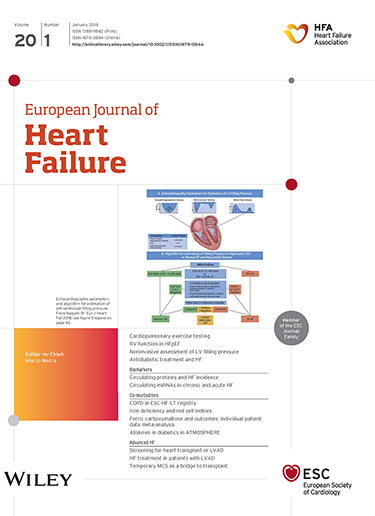Effects of finerenone on natriuretic peptide levels in heart failure with mildly reduced or preserved ejection fraction: The FINEARTS-HF trial.
IF 10.8
1区 医学
Q1 CARDIAC & CARDIOVASCULAR SYSTEMS
引用次数: 0
Abstract
AIMS N-terminal pro-B-type natriuretic peptide (NT-proBNP) concentrations serve as markers of prognosis and therapeutic response in patients with heart failure (HF). The effect of the non-steroidal mineralocorticoid receptor antagonist finerenone on NT-proBNP in patients with HF with mildly reduced or preserved ejection fraction (HFmrEF/HFpEF) is currently unknown. METHODS AND RESULTS The FINEARTS-HF trial randomized patients with HFmrEF/HFpEF and NT-proBNP ≥300 pg/ml (≥900 pg/ml if atrial fibrillation) or B-type natriuretic peptide ≥100 pg/ml (≥300 pg/ml if atrial fibrillation) to finerenone versus placebo. Core laboratory NT-proBNP was measured at baseline, 3, and 12 months after randomization. We evaluated the association between log-transformed NT-proBNP and the primary outcome (cardiovascular death and total HF events), whether baseline NT-proBNP modified the effect of finerenone on this outcome, and the effect of finerenone on NT-proBNP concentration. Baseline NT-proBNP was available in 5843 of 6001 patients analysed (median 1041 [interquartile range 449-1946] pg/ml) and was strongly associated with risk of the primary outcome (adjusted rate ratio 1.44 per doubling in biomarker concentration, 95% confidence interval [CI] 1.37-1.51], p < 0.001). Baseline NT-proBNP did not modify the benefit of finerenone on the primary outcome (pinteraction = 0.92). Finerenone reduced NT-proBNP by 12.1% (95% CI 8.5-15.4%) at 3 months and 12.5% (95% CI 8.1-16.7%) at 12 months, compared to placebo. CONCLUSIONS In patients with HFmrEF/HFpEF, finerenone reduced NT-proBNP within months of initiation, and improved clinical outcomes regardless of baseline NT-proBNP concentration. CLINICAL TRIAL REGISTRATION ClinicalTrials.gov NCT04435626, EudraCT 2020-000306-29.芬尼烯酮对射血分数轻度降低或保留的心力衰竭患者利钠肽水平的影响:FINEARTS-HF试验
aimsn末端前b型利钠肽(NT-proBNP)浓度可作为心衰(HF)患者预后和治疗反应的指标。非甾体矿物皮质激素受体拮抗剂芬烯酮对射血分数轻度降低或保留的HF患者NT-proBNP的影响目前尚不清楚。方法和结果FINEARTS-HF试验将HFmrEF/HFpEF和NT-proBNP≥300 pg/ml(房颤≥900 pg/ml)或b型利钠肽≥100 pg/ml(房颤≥300 pg/ml)的患者随机分为芬尼酮和安慰剂两组。在随机分组后的基线、3个月和12个月测量核心实验室NT-proBNP。我们评估了对数转换NT-proBNP与主要结局(心血管死亡和总心衰事件)之间的关系,基线NT-proBNP是否改变了芬尼酮对这一结局的影响,以及芬尼酮对NT-proBNP浓度的影响。在分析的6001例患者中,有5843例可获得基线NT-proBNP(中位数为1041[四分位数间距449-1946]pg/ml),并且与主要结局的风险密切相关(生物标志物浓度每增加一倍调整后的比率为1.44,95%可信区间[CI] 1.37-1.51, p < 0.001)。基线NT-proBNP并没有改变芬芬酮对主要结局的益处(p - interaction = 0.92)。与安慰剂相比,芬纳酮在3个月时降低了12.1% (95% CI 8.5-15.4%)的NT-proBNP,在12个月时降低了12.5% (95% CI 8.1-16.7%)。结论:在HFmrEF/HFpEF患者中,细芬烯酮在开始治疗的几个月内降低了NT-proBNP,并改善了临床结果,而与基线NT-proBNP浓度无关。临床试验注册号:clinicaltrials .gov NCT04435626, eudraft: 2020-000306-29。
本文章由计算机程序翻译,如有差异,请以英文原文为准。
求助全文
约1分钟内获得全文
求助全文
来源期刊

European Journal of Heart Failure
医学-心血管系统
CiteScore
27.30
自引率
11.50%
发文量
365
审稿时长
1 months
期刊介绍:
European Journal of Heart Failure is an international journal dedicated to advancing knowledge in the field of heart failure management. The journal publishes reviews and editorials aimed at improving understanding, prevention, investigation, and treatment of heart failure. It covers various disciplines such as molecular and cellular biology, pathology, physiology, electrophysiology, pharmacology, clinical sciences, social sciences, and population sciences. The journal welcomes submissions of manuscripts on basic, clinical, and population sciences, as well as original contributions on nursing, care of the elderly, primary care, health economics, and other related specialist fields. It is published monthly and has a readership that includes cardiologists, emergency room physicians, intensivists, internists, general physicians, cardiac nurses, diabetologists, epidemiologists, basic scientists focusing on cardiovascular research, and those working in rehabilitation. The journal is abstracted and indexed in various databases such as Academic Search, Embase, MEDLINE/PubMed, and Science Citation Index.
 求助内容:
求助内容: 应助结果提醒方式:
应助结果提醒方式:


